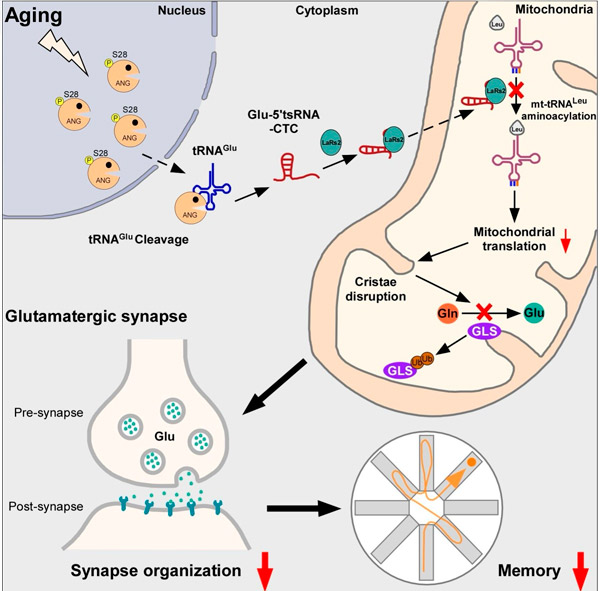
14 May 2024, 13:35
中国科学技术大学刘强教授团队在《细胞代谢》杂志上发表的研究文章揭示了谷氨酸tRNA片段在脑衰老和阿尔茨海默病中的关键作用。
研究揭示了谷氨酸能神经元线粒体中Glu-5'tsRNA-CTC(一种源自转移RNA (tsRNA)的小RNA,而tsRNA由核编码的tRNAGlu形成)的积累与年龄相关。这种异常积累会破坏线粒体蛋白质翻译和嵴结构,最终加速大脑衰老和阿尔茨海默病的病理过程。
大脑衰老是一个不可避免的自然过程,会导致认知能力下降。阿尔茨海默病是一种神经退行性疾病,是老年人痴呆症最常见的病因,其显著特征是认知障碍。线粒体为细胞提供能量。研究表明,线粒体功能障碍与大脑衰老和阿尔茨海默病密切相关。
线粒体Glu-5'tsRNA-CTC会破坏mt-tRNALeu与亮氨酰-tRNA合成酶2(LARS2)的结合,从而损害mt-tRNALeu的氨酰化和线粒体编码蛋白的翻译。线粒体翻译缺陷会破坏嵴结构,导致谷氨酰胺酶依赖性谷氨酰胺(GLS)形成受损,突触谷氨酸水平降低。此外,降低Glu-5'tsRNA-CTC水平可能保护衰老大脑免受与年龄相关的线粒体嵴、谷氨酰胺代谢、突触结构和记忆缺陷的影响。

TRNA片段在脑衰老与阿尔茨海默病中的调控机制示意图。刘强等
刘教授及其团队阐明了谷氨酸tRNA片段在大脑衰老和阿尔茨海默病中的重要作用,为减缓认知衰退提供了新的思路。研究人员开发了针对这些tRNA片段的反义寡核苷酸,并将其注射到老年小鼠的大脑中。这种干预措施显著改善了老年小鼠的学习和记忆问题。
除了阐明正常线粒体嵴超微结构在维持谷氨酸水平方面的生理作用外,该研究还发现了 tRNA 在大脑衰老和与年龄相关的记忆力下降中的病理作用。

